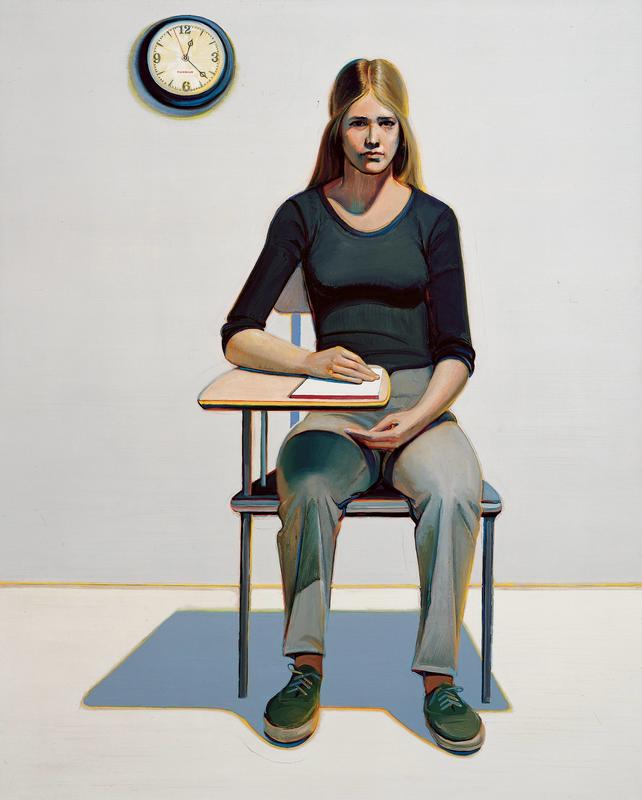Student reflects on the eighth year of Thiebaud's service to the University of California, where he'd remain until 1991.
The painting is life-sized, measuring 152.72 cm x 122.24 cm, just over five feet by four feet, and it's from the collection of Doris and Donald Fisher. Thiebaud taught at the UC campus in a small rural town called Davis, in a department that included Roy De Forest, William T. Wiley, and Robert Arneson. (They also graciously maintain an archive of the writing of your humble author's late Pops.) Though never formally trained himself, Thiebaud was drawn to teaching, getting his master's in art education at Sacramento State, where he taught for nine years before getting the gig at UC Davis. This was arguably a professional step up, but with classic self-deprecating Thiebaud humor, he has lamented that the change meant he could no longer walk to work.
One of Thiebaud's frequent lessons for his students is that there's no replacement for painting: you can't compare it to photography, it doesn't matter if it's fine art or commercial art, and the reproduction of Student that you're looking at is "just a souvenir of the painting; it doesn't have much to do with it." That's disappointing, but if you were hoping that maybe Thiebaud's bright, Fisher-Price colors make for a more faithful reproduction, the artist is ready to shut that one down, too: "Reproduction of a painting is especially disastrous, I think, in my own work." Thiebaud got one of his first art jobs in Walt Disney studios, and, like Andy Warhol (whose work he's not a fan of), he also worked in advertising. The entire advertising game is based on the mechanical reproduction of messages, especially visual ones, and Thiebaud recognizes the irony, admitting that, in reproduction, his work "very often just looks like another ad." Now that he mentions it, Student as an image wouldn't be out of place in a hip magazine, with the pretty blonde co-ed's quintessentially 1960's middle part and effortlessly cool crewneck and Keds.
If you've seen a Thiebaud in person, you will know what he means. Reproductions lose the beautiful painterly quality of his work, the subtleties in the texture of his brushstrokes, and his delicate application of colors. Notice in this work the unusual color choices in the shading: bright yellow around the desk's shadow, the clock, and the crease of the floor, the pops of hot pink along the book and chair. There is really no substitute for standing in front of this life-size canvas where you can see all the interesting details that, when juxtaposed against the plain cream background, lend a certain otherworldliness, or dreamlike quality to his compositions.
Nearing his ninety-ninth trip around the sun, the venerable Thiebaud gave an interview in which he reinforced his love of art criticism, particularly that of Ernst Gombrich. Over a decade earlier, just after a retrospective with the impressive title Wayne Thiebaud: 70 Years of Painting, Thiebaud opened a lecture with a firm testimony about his lack of certainty, and his constant state of doubt as to the value of his career. Painting is disastrous as a vocation, he told the surprised audience, and he has often wondered if he was doing something wrong. In an odd way, this apparent insecurity, combined with a surplus of intensely self-deprecating humor, may have something to do with the longevity of his work, and the popularity of the artist himself.
In his dialogue with the San Francisco Chronicle critic Kenneth Baker, Thiebaud reports that he was sitting with his son, grandchildren and extended family outside during Wayne Thiebaud: Seventy Years of Painting. The family was the picture of suburban success. Now Thiebaud drops a somewhat singular piece of California jargon: a "street person" approached us, he says. The term "street person" usually refers to someone forced by economic, political and/or medical circumstances to survive on the streets, but sometimes it just refers to a local eccentric, as in the case of San Francisco's Emperor Norton, or the inimitable Frank Chu. The "street person" asks Thiebaud's son what they're all doing there. Thiebaud's son says, "We're here for a show commemorating seventy years of my father's painting." "Tell your dad to get a life," says the anonymous, Dionysian "street person." Thiebaud relishes the belly laughs of the audience when he tells this story. The Student does not look intimidated by her teacher, if perhaps a bit skeptical—has Professor Thiebaud just finished telling another humorous tale in which he makes himself the butt of a joke?



















Love this one